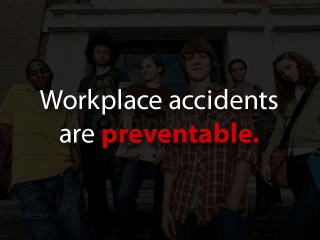
Is your work safety the best it could be? Sometimes companies focus too much on checking items off the lengthy work-safety requirements list and develop blind spots toward other potential problems right under their nose.
Even the most conscientious business can develop a few bad habits over time, especially when it comes to construction-heavy and factory-like environments. When the time comes to review your standards, here are several of the most common weak spots for you to pay close attention to.
Creeping machine wear
Some machine wear is hard to spot. Equipment can run down slowly, and routine maintenance can sometimes lead you to assume that a particular component is fine when it’s actually wearing out.
The problem is that everyone grows used to the machinery’s ongoing condition, which leads to a lot of surprise when the equipment suddenly shuts down or malfunctions and requires expensive repair work. Don’t let creeping machine wear surprise you, and don’t assume that just because a component has functioned perfectly for years that it will continue to be that way.
Be objective when performing routine inspections, and take note of wear and tear when it shows up, not after the fact.
Ignoring non-physical stress
This is a psychological issue, but it’s especially important in busy and highly physical workplaces where a lot of emphasis is placed on safety … but more subtle problems like stress may get shoved to one side. This can lead to overwork, mistakes on the job, and productivity problems.
Stress should be acknowledged as a true workplace safety hazard and dealt with appropriately through available training, programs, and initiatives. Workers should be encouraged to deal with job stress openly and communicate their suggestions.
The best solutions for stress on the job are often identified when employees are made a part of the strategic process.
Environmental problems

Environmental problems often go under our radar because they are literally part of the background, and not as evident in day-to-day operations as the machinery and ongoing duties of workers. However, environmental issues can lead to physical irritation, loss of productivity, and long-term health problems if not dealt with.
OHSA is working hard to keep current with environmental protocols. However, as a general rule, companies should focus on problems like noise levels, lights, and heat. Offer earplugs and training on how to protect your hearing. Listen to complaints about the light quality or the temperature and respond to them actively.
Active ergonomics
Ergonomics has long been the domain of the desk-bound: workers who hunch over computers and spend long periods of time in chairs. However, this ignores an equally important group: the people who engage in repetitive tasks and activities that occur in active workplaces such as factories and construction sites.
Rather than a simple “lift with your legs” warning, employers should offer a broader range of training that shows workers how to accomplish their tasks the right way without risking physical injury through repetitive motion.
Lack of empowerment
What happens when an employee notices a potential health or injury hazard in the workplace? Often, the answer is “nothing,” because workers don’t understand the chain of command when it comes to addressing health concerns.
In other cases, workers report problems to their supervisors, but the latter take no action because they are busy or unsure themselves of where to turn. Workplaces need to empower employees to make changes when they see a problem.
Repair and rest breaks
Most workers are busy people who focus primarily on personal tasks and do not think much, if at all, about workplace safety. They just want to get their jobs done.
Workplaces can have plenty of ideas about safety and preventive maintenance, but unless they give employees room to put those ideas into practice, the strategy will do no good. Room may need to be made in the schedule for mandatory repair and rest breaks for both machines and people.
Lack of repair relationships
What sort of repair relationships does your business have with local contractors? Do you know who to call when you need to solve an issue or arrange a quick fix?
If all you have is a phone number on a website you haven’t visited in months, you may be in trouble. A good workplace safety strategy includes contacts with professionals who can offer necessary services or advice for a price that you can trust.










